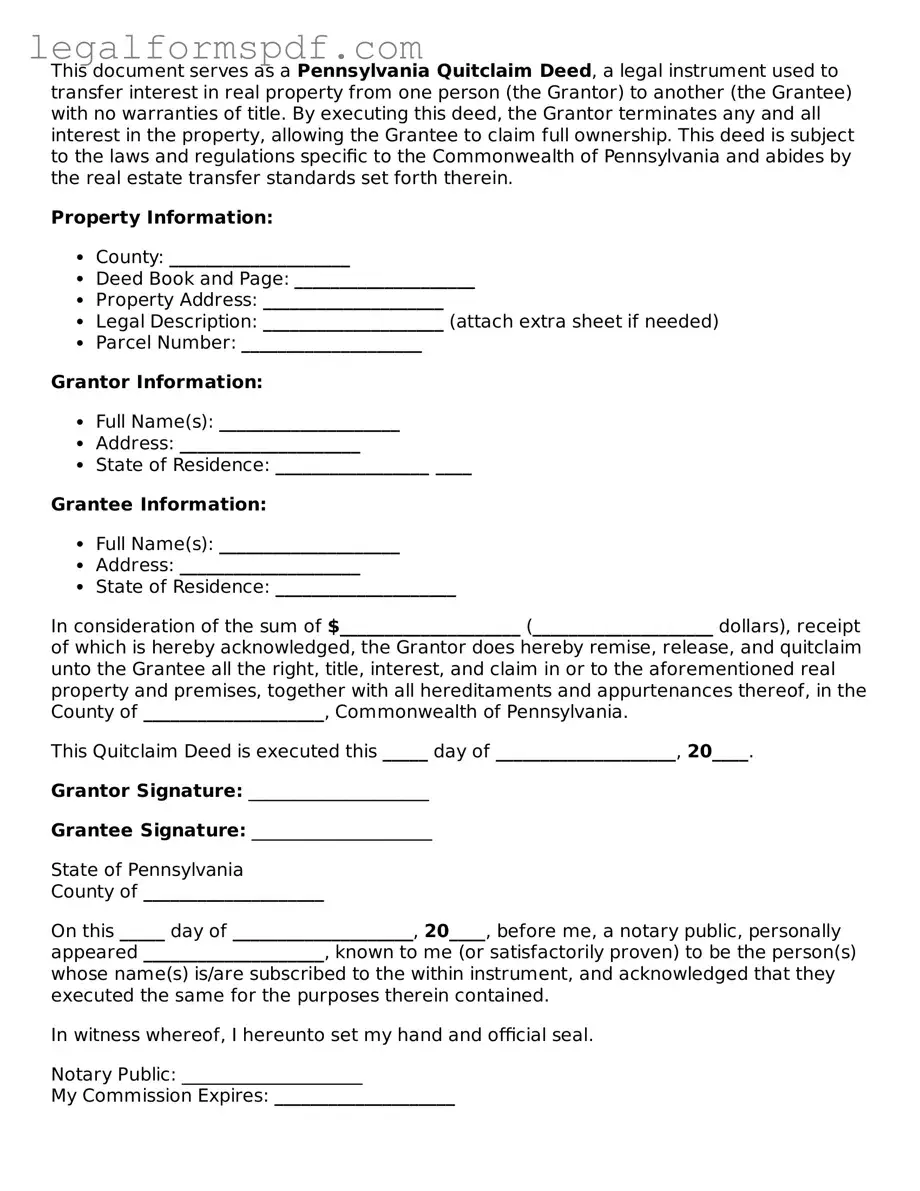What is a Quitclaim Deed in Pennsylvania?
A Quitclaim Deed in Pennsylvania is a legal document used to transfer a person's rights, if any, in a piece of property to another person, without guaranteeing the clear title of said property. Essentially, the person transferring the property (the grantor) makes no promises about the property's ownership status and is simply passing on whatever interest they may have to the recipient (the grantee).
When should I use a Quitclaim Deed in Pennsylvania?
Quitclaim Deeds are commonly used in Pennsylvania to transfer property within a family, such as between spouses or from parents to children, during a divorce settlement, or to clear up a title. They are also utilized in transactions where the property is gifted or transferred without a traditional sale.
Is a Quitclaim Deed in Pennsylvania the same as a Warranty Deed?
No, a Quitclaim Deed differs significantly from a Warranty Deed. A Warranty Deed includes guarantees from the seller about the clear title of the property and its freedom from any claims, such as liens or mortgages. In contrast, a Quitclaim Deed offers no such guarantees or warranties about the property’s title status.
What information is required on a Pennsylvania Quitclaim Deed?
To properly execute a Quitclaim Deed in Pennsylvania, you need the legal description of the property, the names and addresses of the grantor and grantee, and the deed must be signed by the grantor in front of a notary public. The deed then needs to be recorded with the county recorder's office where the property is located.
How do I file a Quitclaim Deed in Pennsylvania?
After ensuring the Quitclaim Deed is correctly filled out, signed, and notarized, it must be filed with the county recorder's office or registry of deeds in the county where the property is located. A recording fee will be required, and the amount can vary by county.
Is a notary required for a Quitclaim Deed in Pennsylvania?
Yes, for a Quitclaim Deed to be legally valid in Pennsylvania, it must be signed by the grantor in the presence of a notary public. The notary's seal or stamp is also necessary to officially notarize the document.
Can I use a Quitclaim Deed to transfer property to a trust in Pennsylvania?
Yes, in Pennsylvania, it is possible to use a Quitclaim Deed to transfer property from an individual to a trust. This is a common practice when individuals are managing their estate planning and wish to move their real estate assets into a trust.
Are there any tax implications with using a Quitclaim Deed in Pennsylvania?
Transferring property through a Quitclaim Deed can have tax implications, including potential realty transfer taxes unless specific exemptions apply. Additionally, there could be federal and state tax consequences for the grantor and grantee. It's advisable to consult with a tax professional to understand the full impact.
Does a Quitclaim Deed ensure I'm buying property free and clear of issues in Pennsylvania?
No, a Quitclaim Deed does not ensure that you are buying a property free from any issues regarding the title, liens, or other encumbrances. It only transfers whatever interest the grantor has in the property, if any, with no warranties. For full protection, a title search and Warranty Deed may be necessary to ensure clear ownership.
